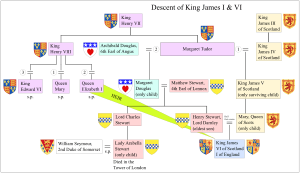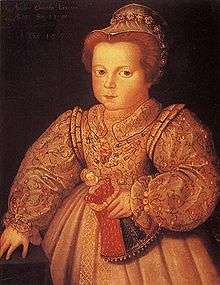Lady Arbella Stuart
Lady Arbella Stuart (1575 – 25 September 1615) (or Arabella, or Stewart) was an English noblewoman who was considered a possible successor to Queen Elizabeth I of England. During the reign of King James VI and I, she married William Seymour, 2nd Duke of Somerset in secret. King James imprisoned William Seymour and placed her under house arrest. When she and her husband tried to escape England, she was captured and imprisoned in the Tower of London, where she died at age 39.[1]
Lady Arbella Stuart | |
|---|---|
 Lady Arbella in her later years | |
| Born | 1575 |
| Died | 25 September 1615 (aged 39–40) Tower of London, England |
| Resting place | Westminster Abbey |
| Nationality | English |
| Known for | Claimant to the English throne |
| Spouse(s) | The 2nd Duke of Somerset |
| Parent(s) | Elizabeth Cavendish Charles Stuart, 1st Earl of Lennox |

Descent
She was the only child of Charles Stuart, 1st Earl of Lennox (of the third creation), by his marriage to Elizabeth Cavendish. She was a grandchild of Matthew Stewart, 4th Earl of Lennox (of the second creation) and Lady Margaret Douglas, the daughter and heiress of Archibald Douglas, 6th Earl of Angus, and of Margaret Tudor, daughter of King Henry VII of England and widow of King James IV of Scotland. Arbella was therefore a great-great-granddaughter of King Henry VII of England and was in line of succession to the English throne, although she did not herself aspire to it.[2]
Her paternal grandparents, the 4th Earl of Lennox and Margaret Douglas, had, of their eight children, two sons who survived childhood: Arbella's father Charles and his older brother Henry Stuart, Lord Darnley, who became the second husband of Mary, Queen of Scots, and the father of Arbella's cousin James VI and I of Scotland, England and Ireland. Her maternal grandparents were Sir William Cavendish and his wife Elizabeth, better known as "Bess of Hardwick".
In her final days as a prisoner in the Tower of London, Arbella Seymour (her married name), refusing to eat, fell ill, and died on 25 September 1615. She was buried in Westminster Abbey on 29 September 1615. In the 19th century, during a search for the tomb of James VI and I, Arbella's lead coffin was found in the vault of Mary, Queen of Scots, placed directly on top of that of the Scots queen.[3]
Childhood

Arbella's father died in 1576 when she was an infant. She was raised by her mother Elizabeth Cavendish, Countess of Lennox, until 1582.[4] The death of her mother left seven-year-old Arbella an orphan, whereupon she became the ward of her grandmother Bess, rather than Lord Burghley, the Master of the Court of Wards, as might have been expected.[5]
During most of her childhood she lived in the protective isolation of Hardwick Hall in Derbyshire with her grandmother, who had married George Talbot, 6th Earl of Shrewsbury, in 1568. It seems she enjoyed periodic visits to the court and to London, including court visits during the summers of 1587 and 1588 and one that lasted from November 1591 to July 1592.[6]
Starting in early 1589 or thereabouts "one Morley ... attended on Arbell and read to her", as reported in a dispatch from Bess of Hardwick to Lord Burghley, dated 21 September 1592.[7] Bess recounts Morley's service to Arbella over "the space of three years and a half". She also notes he had hoped for an annuity of £40 a year (equivalent to £11,100 in 2019) from Arbella based on the fact that he had "been so much damnified [i.e. that much out of pocket] by leaving the University". This has led to speculation that Morley was the poet Christopher Marlowe,[8] whose name was sometimes spelled that way.
Heiress to the English throne
For some time before 1592, Arbella was considered one of the natural candidates to succeed her first cousin twice removed, Queen Elizabeth I.[9] However, between the end of 1592 and the spring of 1593, the influential Cecils – Elizabeth's Lord Treasurer, Lord Burghley, and his son, Secretary of State Sir Robert Cecil – turned their attention away from Arbella towards her cousin James VI of Scotland, regarding him as a preferable successor.[10]
Sometimes she was invited to Elizabeth's court, but much of her time she spent away living with her grandmother. Continuing her education into her twenties, she studied several languages and could play the lute, viol and virginals.[11]
In 1603, after James's accession as James I of England, those involved in the Main Plot allegedly conspired to overthrow him and put Arbella on the throne. When she was invited to participate by agreeing in writing to Philip III of Spain, however, she immediately reported the invitation to the king.[12]
Marriage negotiations
Owing to Arbella's status as a possible heir to the throne, there were discussions of appropriate marriages for her throughout her childhood.
In 1588, it was proposed to James VI of Scotland that Ludovic Stuart, 2nd Duke of Lennox, should be married to Arbella, but nothing seems to have come of this suggestion either.[13] James VI was interested in this match but the Countess of Lennox's servant Thomas Fowler discouraged him.[14] Other potential matches were the sons of Alexander Farnese, Duke of Parma, who could claim the English throne as descendants of John of Gaunt. The idea was to secure toleration for English Catholics or even win Arbella for the Catholic faith. However, the eldest son, Ranuccio, was already married, and the younger son, Odoardo, was a Cardinal. The Pope was reportedly prepared to absolve Odoardo from his obligations but the resistance of Queen Elizabeth I to such a marriage stopped the plan probably even before Arbella could be approached.[7]
In the closing months of Elizabeth's reign, Arbella fell into trouble through reports that she intended to marry Edward Seymour, a member of the prominent Seymour family. This was reported to the Queen by the supposed groom's grandfather, Edward Seymour, 1st Earl of Hertford. Arbella denied having any intention of marrying without the Queen's permission. In 1604, Sigismund III Vasa, King of Poland, sent an ambassador to England to ask for Arbella to be his wife. This offer was rejected.[15]
Marriage to William, Lord Beauchamp

On 5 June 1610 Arbella danced in Samuel Daniel's masque Tethys' Festival, one of the festivities at the investiture of Prince Henry as Prince of Wales. She followed, in order of precedence, Anne of Denmark and Princess Elizabeth.[16]
Arbella, who was fourth in line to the English throne, was in trouble again in 1610 for planning to marry William Seymour, then known as Lord Beauchamp, who later succeeded as 2nd Duke of Somerset. Lord Beauchamp was sixth-in-line, grandson of Lady Katherine Grey, a younger sister of Lady Jane Grey and a granddaughter of Mary Tudor, younger sister of King Henry VIII and Arbella's ancestor, Margaret Tudor. Under the circumstances, the King wondered whether the marriage was the prelude to an attempt to seize the Crown itself.
Although the couple at first denied that any arrangement existed between them, they later married in secret on 22 June 1610 at Greenwich Palace. For marrying without his permission, King James imprisoned them: Arbella in Sir Thomas Perry's house in Lambeth and Lord Beauchamp in the Tower of London. The couple had some liberty within those buildings, and some of Arbella's letters to Beauchamp and to the King during this period survive. When the King learned of her letters to Lord Beauchamp, however, he ordered Arbella's transfer to the custody of William James, Bishop of Durham. Arbella claimed to be ill, so her departure for Durham was delayed.
The couple used that delay to plan their escape. Arbella dressed as a man and escaped to Lee (in Kent), but Lord Beauchamp did not meet her there before their getaway ship was to sail for France. Sara Jayne Steen records that Imogen, the virtuous, cross-dressed heroine of William Shakespeare's play Cymbeline (1610–1611), has sometimes been read as a reference to Arbella[17] but the warrant for the couple's arrest is dated 3 June 1611 and Simon Forman recorded seeing a production of that play 2 months earlier in April.
Beauchamp did escape from the Tower, but by the time he reached Lee, Arbella was gone, so he caught the next ship to Flanders. Arbella's ship was overtaken by King James's men just before it reached Calais, France. She was returned to England and imprisoned in the Tower of London. She never saw her husband again and died in the Tower on 25 September 1615 from illnesses exacerbated by her refusal to eat.
Literary legacy
Over one hundred letters written by Arbella have survived. In 1993, a collection of them was published, edited by Sara Jayne Steen, providing details of her activities and ideas. The English novelist and historical biographer Doris Leslie wrote 'Wreath for Arabella' in 1948. Emilia Lanier's poem Salve Deus Rex Judaeorum is dedicated to Arbella. Lanier recalls a former personal friendship with Arbella that was unrequited; she addresses her as "Great learned Ladie ... whom long I have known but not known so much as I desired".
Felicia Hemans' poem Arabella Stuart is about Arbella, imagining her thoughts as she died in prison. In 2005, Sarah Gristwood published Arbella: England's Lost Queen.
Family tree
| James III of Scotland | Henry VII | ||||||||||||||||||||||||||||||||||||||||||||||||||||||||||
| James IV of Scotland | Margaret Tudor | Henry VIII of England | Mary Tudor | ||||||||||||||||||||||||||||||||||||||||||||||||||||||||
| James V of Scotland | Margaret Douglas | Mary I of England | Elizabeth I of England | Edward VI | Frances Brandon | ||||||||||||||||||||||||||||||||||||||||||||||||||||||
| Mary, Queen of Scots | Henry Stuart | Charles Stuart | Jane Grey | Katherine Grey | |||||||||||||||||||||||||||||||||||||||||||||||||||||||
| Edward Seymour | |||||||||||||||||||||||||||||||||||||||||||||||||||||||||||
| James VI and I | Arbella Stuart | William Seymour | |||||||||||||||||||||||||||||||||||||||||||||||||||||||||
Ancestry
| Ancestors of Lady Arbella Stuart | ||||||||||||||||||||||||||||||||||||||||||||||||||||||||||||||||||||||||||||||||||||||||||||||||||||||||||||||||||||||||||||||||||||||||||||||||||||||||||||||||||||||||||||||||||||||||||||||||||||||||||||||||||||||||||||||||||||||||||||||||||||||||||||||||||||||||||||||||||||||||||||||||||||||||||||||||||||||||||||||||||||||||||||||||||||||||||||||||||||||||||||||||||||||||||||||||||||||||||||||||||||||||||||||||||||||||||||||||||||||||||||||||||||||||||||||||||||||||||||||||||||||||||||||||||||||||||||||||||||||||||||||||||||||||||||||||||||||||||||||||||||||||||||||||||||||||||||||||
|---|---|---|---|---|---|---|---|---|---|---|---|---|---|---|---|---|---|---|---|---|---|---|---|---|---|---|---|---|---|---|---|---|---|---|---|---|---|---|---|---|---|---|---|---|---|---|---|---|---|---|---|---|---|---|---|---|---|---|---|---|---|---|---|---|---|---|---|---|---|---|---|---|---|---|---|---|---|---|---|---|---|---|---|---|---|---|---|---|---|---|---|---|---|---|---|---|---|---|---|---|---|---|---|---|---|---|---|---|---|---|---|---|---|---|---|---|---|---|---|---|---|---|---|---|---|---|---|---|---|---|---|---|---|---|---|---|---|---|---|---|---|---|---|---|---|---|---|---|---|---|---|---|---|---|---|---|---|---|---|---|---|---|---|---|---|---|---|---|---|---|---|---|---|---|---|---|---|---|---|---|---|---|---|---|---|---|---|---|---|---|---|---|---|---|---|---|---|---|---|---|---|---|---|---|---|---|---|---|---|---|---|---|---|---|---|---|---|---|---|---|---|---|---|---|---|---|---|---|---|---|---|---|---|---|---|---|---|---|---|---|---|---|---|---|---|---|---|---|---|---|---|---|---|---|---|---|---|---|---|---|---|---|---|---|---|---|---|---|---|---|---|---|---|---|---|---|---|---|---|---|---|---|---|---|---|---|---|---|---|---|---|---|---|---|---|---|---|---|---|---|---|---|---|---|---|---|---|---|---|---|---|---|---|---|---|---|---|---|---|---|---|---|---|---|---|---|---|---|---|---|---|---|---|---|---|---|---|---|---|---|---|---|---|---|---|---|---|---|---|---|---|---|---|---|---|---|---|---|---|---|---|---|---|---|---|---|---|---|---|---|---|---|---|---|---|---|---|---|---|---|---|---|---|---|---|---|---|---|---|---|---|---|---|---|---|---|---|---|---|---|---|---|---|---|---|---|---|---|---|---|---|---|---|---|---|---|---|---|---|---|---|---|---|---|---|---|---|---|---|---|---|---|---|---|---|---|---|---|---|---|---|---|---|---|---|---|---|---|---|---|---|---|---|---|---|---|---|---|---|---|---|---|---|---|---|---|---|---|---|---|---|---|---|---|---|---|---|---|---|---|---|---|---|---|---|---|---|---|---|---|---|---|---|---|---|---|---|---|---|---|---|---|---|---|---|---|---|---|---|---|---|---|---|---|---|---|---|---|---|---|---|---|---|---|---|---|---|---|---|---|---|---|---|---|---|---|---|---|---|---|---|---|---|---|---|---|---|---|---|---|---|---|---|---|---|---|---|---|---|---|---|---|---|---|---|---|---|---|---|---|---|---|---|---|---|---|---|---|---|---|---|---|---|---|---|---|---|---|---|---|---|---|
| ||||||||||||||||||||||||||||||||||||||||||||||||||||||||||||||||||||||||||||||||||||||||||||||||||||||||||||||||||||||||||||||||||||||||||||||||||||||||||||||||||||||||||||||||||||||||||||||||||||||||||||||||||||||||||||||||||||||||||||||||||||||||||||||||||||||||||||||||||||||||||||||||||||||||||||||||||||||||||||||||||||||||||||||||||||||||||||||||||||||||||||||||||||||||||||||||||||||||||||||||||||||||||||||||||||||||||||||||||||||||||||||||||||||||||||||||||||||||||||||||||||||||||||||||||||||||||||||||||||||||||||||||||||||||||||||||||||||||||||||||||||||||||||||||||||||||||||||||
Bibliography
- Cooper, Elizabeth, The Life and Letters of Lady Arabella Stuart (1866)
- Blanche Christabel Hardy, Arbella Stuart: A Biography (1913)
- P. M. Handover, Arbella Stuart: Royal Lady of Hardwick (1957)
- Conyers Read, Lord Burghley and Queen Elizabeth (1960)
- David N. Durant, Arbella Stuart: A Rival to the Queen (1978)
- Ruth Talbot Plimpton, Mary Dyer: Biography of a Rebel Quaker (1994)
- Sarah Jayne Steen, ed., The Letters of Lady Arbella Stuart (1994)
- Sarah Gristwood, Arbella: England's Lost Queen (2003)
- Terry Kilburn. Hardwick's Royal Princess: Arbella Stuart, 1575-1615 (2013, 2015)
References
- "The Story of Lady Arbella Stuart". National Trust UK. National Trust UK. Retrieved 29 March 2020.
- Rosalind K. Marshall, Stuart, Lady Arabella (1575–1615), Oxford Dictionary of National Biography, Oxford University Press, 2004 accessed 3 March 2008
- Stanley, A. P. (1886). Westminster Abbey. London: John Murray. p. 499.
- Antonia Fraser, Mary, Queen of Scots, p. 535
- Sarah Gristwood, Arbella: England's Lost Queen, Bantam, 2003, p.49
- David N. Durant, Arbella Stuart: A Rival to the Queen, 1978, pp.41, 51, 61
- Blanche C. Hardy, Arbella Stuart: A Biography, Dutton, 1913, pp.64–67
- Charles Nicholl, The Reckoning: The Murder of Christopher Marlowe, 1992, pp.340–342
- Marshall, p.601
- Handover, The Second Cecil, 55-6; 297; Read, Lord Burghley, 484
- Lovell, Mary S. (2005). Bess of Hardwick, First Lady of Chatsworth. Little, Brown. pp. 408–409.
- Gristwood, pp. 267–269
- Gristwood, p.109
- Calendar State Papers Scotland, vol. 10 (Edinburgh, 1936), p. 17.
- Gristwood, p. 301–302
- Memorials of Affairs of State from the papers of Ralph Winwood, vol. 3 (London, 1725), p. 181: Roy Strong, Henry Prince of Wales (London, 1986), pp. 155-158.
- Steen, 96
Sources
- Marshall, Rosalind. "Arabella Stuart." Dictionary of National Biography. Oxford: Oxford University Press, 2004.
